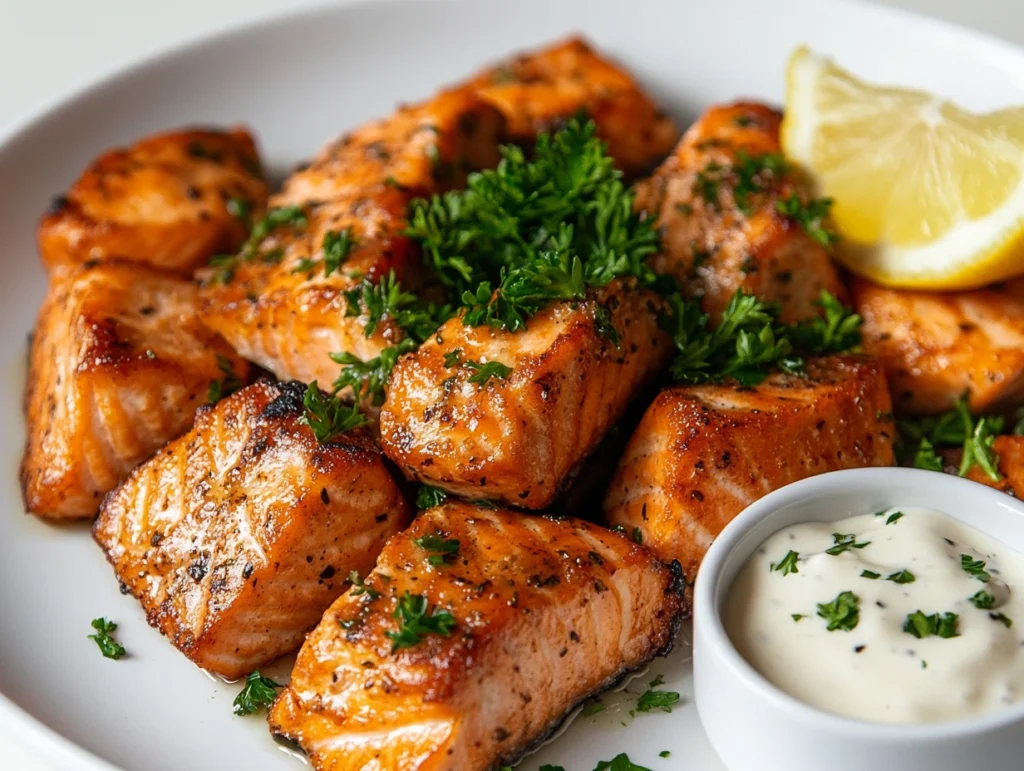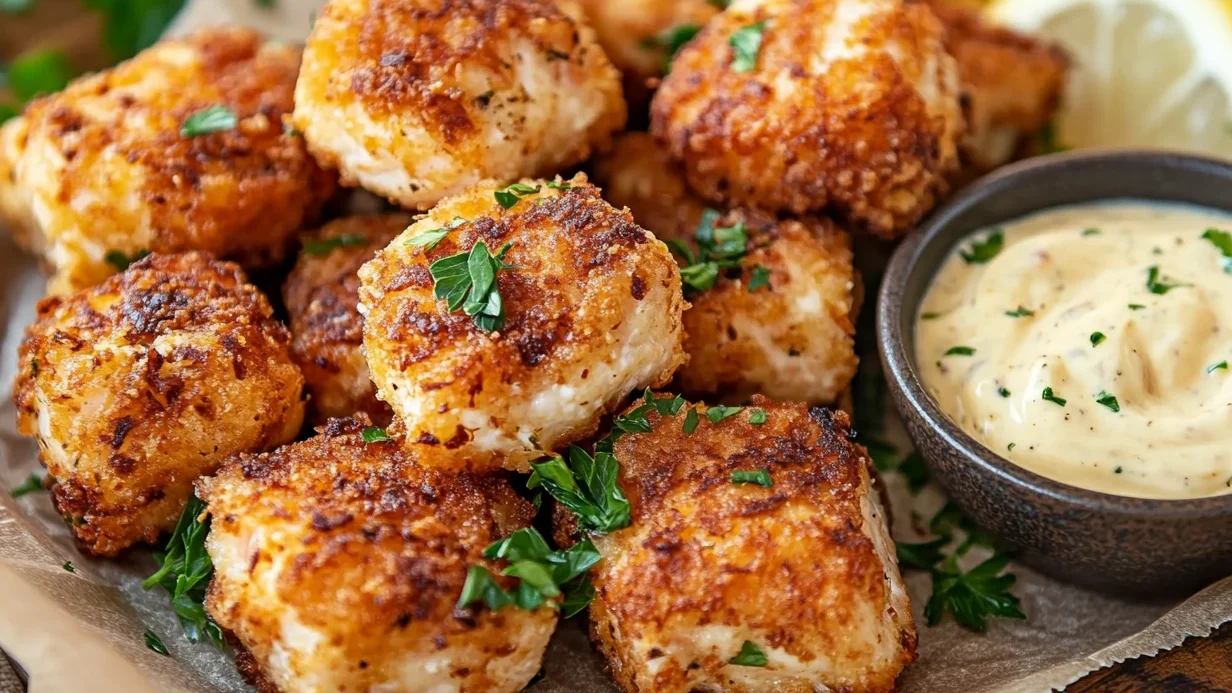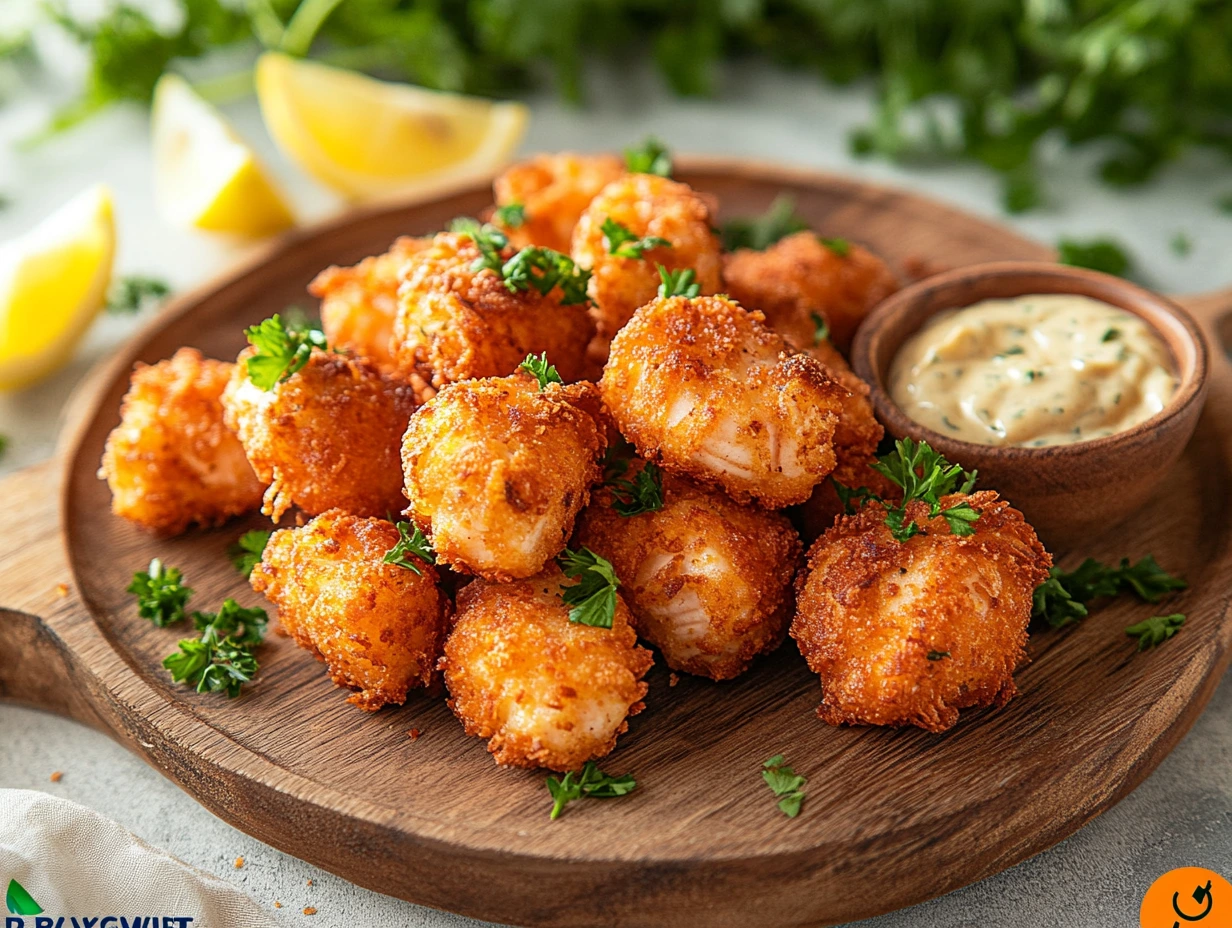How to Make Fried Salmon Bites Everyone Will Love

If you’ve ever found yourself wondering what to cook for a crowd-pleasing appetizer, a quick family snack, or even a fun twist on dinner, fried salmon bites are the answer. Bite-sized, crispy, and packed with flavor, these little nuggets of joy are a sure hit. They’re the kind of dish you can whip up with minimal effort but maximum payoff—who doesn’t love something fried, after all?
Today, I’m going to walk you through everything you need to know to make the perfect fried salmon bites. From choosing the right ingredients to troubleshooting common mistakes, this guide has you covered. So, let’s get started!
What Makes Fried Salmon Bites So Special?
First, let’s talk about why fried salmon bites are so awesome. They’re not just “food”; they’re an experience. Imagine the crunch as you bite into one, followed by the juicy, tender salmon inside. It’s the kind of dish that disappears from the plate before you can say, “Who wants more?”
Why You’ll Love Them:
- Quick and Easy: Even if you’re not a seasoned cook, this recipe is foolproof. It’s all about simple steps and ingredients.
- Customizable: Whether you like your food spicy, mild, or bursting with herbs, you can tweak this recipe to suit your taste.
- Perfect for Sharing: These are ideal for parties, game nights, or just a casual dinner where you don’t feel like using a fork and knife.
Doesn’t that sound amazing? Let’s move on to the fun part—the cooking!
Gathering Your Ingredients
Before you start frying up a storm, make sure you have everything ready. Trust me, having all your ingredients set out makes cooking so much more enjoyable.
Here’s what you’ll need:
The Essentials:
- Fresh Salmon Fillet: Skinless is best, but if it has skin, you can easily remove it with a sharp knife. Make sure to cut the salmon into evenly sized cubes for even cooking.
- Buttermilk: This is your secret weapon for tender, flavorful bites. It adds a slight tang and helps the coating stick.
- Flour and Cornstarch: These two work together to create a light but crispy coating.
- Eggs: These help the breadcrumbs stick to the salmon like glue.
- Panko Breadcrumbs: The hero of crunch. They’re light and airy, which makes your bites extra crispy.
- Spices: Paprika, garlic powder, cayenne pepper (if you like a little heat), and salt. You can get creative here if you like other flavors.
- Oil: Go for a neutral, high-heat oil like vegetable or canola oil.
Prepping the Salmon
Here’s where the magic begins. Start with a fresh salmon fillet. If you’re wondering, “How small should I cut the pieces?” think bite-sized—about an inch or so. You don’t want them too big, or they might not cook evenly.
Once your salmon is cubed, pat it dry with a paper towel. Trust me, this step is crucial. If the salmon is too wet, the coating won’t stick, and you’ll end up with a mess. Nobody wants that.
Creating the Perfect Marinade
Marinating the salmon isn’t just a step—it’s a moment to infuse flavor. In a bowl, mix buttermilk with a sprinkle of garlic powder, paprika, and a pinch of salt. Toss your salmon cubes in the marinade and let them soak for at least 20 minutes. You can even leave them for an hour if you’re feeling patient. The buttermilk works its magic, tenderizing the fish and adding just the right tangy touch.
Setting Up Your Coating Station
This is where things start to get exciting. Picture a little assembly line:
- Bowl One: A mix of flour, cornstarch, and a hint of cayenne pepper for an extra kick.
- Bowl Two: Beaten eggs—simple and effective.
- Bowl Three: Panko breadcrumbs with a dash of paprika and black pepper for added flavor.
Dip each piece of salmon into the flour mixture, then into the egg wash, and finally into the breadcrumbs. Give each piece a little press in the breadcrumbs to make sure they’re fully coated. Trust me, this step is oddly satisfying.
The Joy of Frying
Now comes the best part—frying. Heat your oil in a deep skillet or pan. The ideal temperature is around 350°F (175°C). If you don’t have a thermometer, you can test the oil by dropping in a small piece of bread. If it sizzles and turns golden in about 10 seconds, you’re good to go.
Carefully place your salmon bites into the hot oil, a few at a time. Don’t overcrowd the pan; it’s better to fry in batches. Fry them for about 2-3 minutes or until they’re beautifully golden brown. Use a slotted spoon to remove them and place them on a plate lined with paper towels.
How to Serve Fried Salmon Bites
Here’s where you can get creative. Fried salmon bites are so versatile, and they pair beautifully with all sorts of sauces and sides. Here are some ideas:
- Dipping Sauces: Think spicy mayo, honey mustard, garlic aioli, or even a tangy barbecue sauce.
- On a Platter: Arrange them on a bed of mixed greens with a side of lemon wedges. It looks fancy, but it’s so simple.
- With Sides: Serve them with crispy fries, a light salad, or roasted veggies for a more complete meal.
And if you’re anything like me, you might just end up eating them straight off the plate with your fingers. No judgment here!
Mix It Up: Variations to Try
Once you’ve mastered the classic version, why not experiment a little? Here are some fun variations:
- Herb-Crusted: Add chopped fresh parsley or dill to the breadcrumb mixture for a burst of freshness.
- Spicy Kick: Mix in extra cayenne pepper or chili powder if you love heat.
- Cheesy Twist: Add grated Parmesan to the breadcrumb coating for an extra layer of flavor.
- Asian-Inspired: Use sesame seeds in the coating and serve with a soy-based dipping sauce.
Pro Tips for Making the Best Salmon Bites
- Stay Organized: Set up your coating station and frying area before you start. It makes the process so much smoother.
- Test a Piece First: Fry one salmon bite as a test to check the seasoning and cooking time. Adjust if needed.
- Keep the Oil Clean: If you’re frying in batches, skim out any bits of coating that fall off. This prevents them from burning and affecting the flavor.
Creative Ways to Enjoy Fried Salmon Bites
Fried salmon bites are not just limited to traditional deep frying. Depending on your preferences and available kitchen tools, there are several ways to prepare and enjoy this delightful dish. Let’s explore some variations and ideas, incorporating different methods, ingredients, and serving options.
Fried Salmon Bites in an Air Fryer
If you’re looking for a less oily option without compromising on crunch, the air fryer is your best friend. It’s a fantastic tool for getting that golden crispiness with just a fraction of the oil. Simply follow the same coating process, then arrange your salmon bites in a single layer in the air fryer basket. Cook them at 375°F (190°C) for 8-10 minutes, shaking the basket halfway through to ensure even crisping. The result? Crispy, delicious bites that are just as good as their deep-fried counterparts.
Fried Salmon Bites with Flour
Flour is a key ingredient for creating a light, crispy exterior. In this version, you’ll use a simple flour-based coating mixed with spices like paprika and garlic powder. Dipping the marinated salmon in seasoned flour ensures that each piece gets a uniform, flavorful crust. The flour also helps lock in moisture, keeping the salmon tender on the inside while the outside becomes beautifully golden brown during frying.
Crispy Fried Salmon Bites Recipe
Achieving the perfect crunch is all about the right combination of ingredients and technique. For ultra-crispy fried salmon bites, the secret lies in using both cornstarch and panko breadcrumbs in the coating. Cornstarch makes the coating lighter, while panko adds an irresistible crunch. Marinate your salmon, coat it thoroughly, and fry it at the correct oil temperature for bites that are crispy on the outside and juicy inside. This method is sure to win over even the pickiest eaters.
Pan-Fried Salmon Bites
Don’t have a deep fryer or air fryer? No problem! Pan frying is a quick and easy way to make salmon bites with minimal equipment. Heat a thin layer of oil in a non-stick skillet and cook the coated salmon pieces in batches. The key is to ensure the oil is hot enough to sizzle but not so hot that the exterior burns before the inside cooks. Flip them halfway through for even browning. This method works great for smaller servings or if you’re short on time.
Fried Salmon Bites with Sauce
Fried salmon bites are taken to the next level when paired with the right sauce. While tartar sauce and spicy mayo are classics, you can experiment with unique options like honey mustard, garlic aioli, or sweet chili sauce. For a bold twist, try a tangy lemon-dill yogurt dip or a rich teriyaki glaze. The combination of crispy bites and flavorful sauces creates an irresistible harmony of textures and tastes.
Fried Salmon Bites at Restaurants
If you’re dining out and see fried salmon bites on the menu, don’t hesitate to try them! Many restaurants put their own spin on this popular dish, offering unique seasonings, premium salmon cuts, and creative dipping sauces. From upscale seafood spots to casual eateries, fried salmon bites have become a favorite option for appetizers and small plates. Exploring how different chefs prepare them can also inspire you to tweak your own recipe at home.
Fried Salmon Bites and Sides
The beauty of fried salmon bites is that they pair well with so many sides, allowing you to create a meal that’s as simple or elaborate as you like. Here are some ideas:
- Crispy Fries: A classic pairing that’s always a hit.
- Coleslaw: The crunch and tanginess of slaw balance the richness of the salmon.
- Rice Pilaf: A light, herbed rice dish makes for a satisfying accompaniment.
- Roasted Veggies: Add a touch of healthiness with roasted asparagus, carrots, or zucchini.
- Garlic Bread: Perfect for soaking up any leftover sauce.
- Salad: A fresh side salad with a lemon vinaigrette is a refreshing contrast to the fried bites.
No matter what you choose, sides are an opportunity to elevate the dish and create a complete, satisfying meal.

Frequently Asked Questions
Does salmon taste good deep-fried?
Absolutely! Deep-fried salmon has a rich, crispy texture on the outside while staying tender and juicy inside. The frying process enhances the natural flavor of the fish, and when paired with seasonings or coatings like panko breadcrumbs, it becomes irresistibly delicious. It’s a great way to enjoy salmon in a fun and flavorful form, especially for those who might not usually choose seafood.
Should salmon be baked or fried?
Both methods have their advantages, and the choice depends on what you’re looking for. Baking is a healthier option that’s easy and requires minimal effort, often ideal for preparing salmon fillets with herbs and a light marinade. Frying, on the other hand, offers a crispy exterior and bold flavors, especially in dishes like fried salmon bites. If you’re in the mood for something indulgent and crunchy, frying is the way to go.
How long does it take for salmon to fry?
When frying bite-sized pieces of salmon, it typically takes about 2-3 minutes per batch in oil heated to 350°F (175°C). For pan-fried salmon fillets, the cooking time is slightly longer, around 3-4 minutes per side, depending on the thickness of the fillet. The key is to ensure the salmon is golden and cooked through without overcooking, which can dry it out.
How do you fry salmon without it falling apart?
The key to keeping salmon intact while frying is proper preparation and technique. Start by patting the salmon dry to remove excess moisture, which helps the coating stick. Cut it into even pieces to ensure consistent cooking. Use a gentle hand when turning the pieces in the oil, and don’t overcrowd the pan. Coating the salmon in a batter, flour, or breadcrumbs also provides a protective layer that holds the fish together during frying.
Why Fried Salmon Bites Are a Winner Every Time
If you’ve made it this far, you’re probably itching to get into the kitchen. And I don’t blame you! Fried salmon bites aren’t just a dish—they’re a memory waiting to be made. They’re perfect for family dinners, casual get-togethers, or even just treating yourself after a long day.
So, grab your salmon, heat up that oil, and get ready to enjoy a dish that’s as fun to make as it is to eat. Once you take that first crispy, juicy bite, you’ll understand why this recipe is such a keeper.
More Delicious Recipes to Explore

